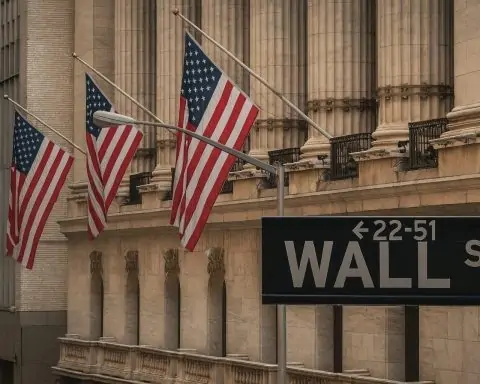- 10‑year U.S. Treasury yields dipped to just above 4% early Monday, while 2‑year yields edged higher, flattening the yield curve at the start of a holiday‑shortened week. [1]
- The 2025 bond rally is now in a “data vacuum” phase as investors wait for a flood of delayed government reports following a 43‑day shutdown that froze key releases like GDP, CPI and jobs data. [2]
- Fed Governor Christopher Waller backs a December rate cut but warns January is “trickier”, underscoring that monetary policy decisions will hinge on how the delayed data lands in coming weeks. [3]
Yields drift lower as the week begins
U.S. Treasury markets opened the week with a cautious tone. As of early Monday trading, the 10‑year Treasury yield was around 4.05%, slightly below Friday’s close near 4.07%, according to MarketWatch data. [4]
At the same time, the 2‑year yield was roughly 3.52%, a touch higher than its prior close, leaving the spread between 10‑ and 2‑year notes at about 0.53 percentage point – a modest but notable flattening of the curve. [5]
Short‑term rates remain elevated:
- 3‑month Treasury bill yields sit near 3.9%, only slightly below recent levels. [6]
This configuration leaves the curve positively sloped but relatively flat, especially compared with the deep inversion seen earlier in the tightening cycle. Research from the Cleveland Fed notes that flatter curves historically signal weaker growth expectations, while steep curves are associated with strong future growth. [7]
A powerful 2025 rally moves into “waiting game” mode
Earlier this year, a surge of demand for Treasuries pushed yields sharply lower, setting up what Bloomberg has described as one of the strongest U.S. bond rallies since 2020. [8]
Key features of that rally:
- Long‑dated yields retreated from their 2023–24 highs, with the 10‑year drifting back toward the 4% area last week as volatility in stocks and crypto drove safe‑haven buying. [9]
- Real yields have also fallen from prior peaks, a sign that markets are pricing in both easier Fed policy and more moderate long‑term growth and inflation. [10]
But with Monday’s moves small and the curve only marginally flatter, Treasuries now look “stuck in the mud”, in Bloomberg’s words: range‑bound, with traders reluctant to push yields dramatically higher or lower until they see more official economic evidence. [11]
Government shutdown leaves a lingering data vacuum
This “waiting game” is rooted in a historic 43‑day federal government shutdown that froze a broad swath of U.S. economic statistics.
- Reuters estimates the shutdown inflicted a permanent $11 billion hit to the economy, even as Treasury Secretary Scott Bessent insists there is no recession risk for the economy as a whole. [12]
- The Bureau of Economic Analysis (BEA) delayed key releases such as third‑quarter GDP and September inflation that were initially due in October. [13]
- The Bureau of Labor Statistics (BLS) canceled the October nonfarm‑payrolls report entirely; those figures are now slated to be released alongside November’s data in mid‑December. [14]
Last Thursday, investors finally received the delayed September jobs report, which showed:
- 119,000 jobs added (well above the roughly 51,000 expected)
- Unemployment rising to 4.4%, the highest since 2021
- Downward revisions to July and August, including an August decline of 4,000 jobs [15]
Analysts and Fed officials alike emphasize that this data is “old news” and does not fully capture how the shutdown and subsequent uncertainty affected hiring and spending in October and November.
“Welcome back, U.S. economic data”: what’s coming next
With the government now reopened, federal data releases are slowly returning, but the timetable is compressed and messy.
Citi Private Bank notes that: [16]
- The September employment report (just released) is the first major rescheduled datapoint.
- October CPI, PCE, and third‑quarter GDP still need revised dates after being postponed.
- Markets have sharply repriced expectations for the Fed’s December decision as investors try to infer the economy’s health from a patchwork of private indicators.
Separate “week ahead” guides from Dow Jones and Yahoo Finance emphasize that this Thanksgiving‑shortened week will feature: [17]
- A light calendar on Monday,
- A pick‑up later in the week as delayed GDP and other releases start to filter through, and
- A slate of Treasury auctions, including 13‑ and 26‑week bills and new 2‑year notes, followed by shorter‑term bills later in the week. [18]
In short, the data blackout is ending, but the backlog ensures that markets will be digesting unusually concentrated information bursts into early December.
Fed’s Waller: December cut likely, January “trickier”
Against this backdrop, Federal Reserve Governor Christopher Waller has become a key voice for markets on Monday.
In an interview highlighted by Reuters, Waller argued that: [19]
- A quarter‑point rate cut at the December 9–10 FOMC meeting is appropriate, given a softening labor market and easing inflation.
- The Fed is still flying partly blind: there are no official October jobs or CPI reports available, and November data will not arrive in time for the December meeting.
- Policymakers are therefore relying more heavily on private surveys, anecdotal evidence, and the Fed’s Beige Book to gauge conditions.
Waller warned that January’s meeting will be “trickier”:
- By then, a “flood” of delayed data should reveal whether the economy is cooling further or re‑accelerating.
- If the incoming data confirms weak job growth and moderating inflation, the case for additional cuts will strengthen.
- But if it instead shows a rebound in inflation or hiring, further easing could be put on hold.
Market pricing reflects this uncertainty. Fed‑funds futures now put the probability of a December rate cut around 70%, according to futures data cited by Reuters and Yahoo Finance, down from near‑certainty a month ago. [20]
Citi’s strategy team, in a separate note, characterizes the odds as closer to “50‑50” and urges caution in adding exposure to rate‑sensitive equities until the data picture clears. [21]
Yield curve flattens: what it’s signaling now
Monday’s combination of lower long‑term yields and slightly higher short‑term yields has flattened the Treasury curve further:
- 10‑year vs. 2‑year spread: roughly 0.53 percentage point
- 10‑year vs. 3‑month spread: only about 0.15 percentage point, using a 3‑month yield near 3.9% [22]
Barron’s and the Wall Street Journal both describe the move as a classic “flattening” start to the week, with 10‑year yields drifting lower while 2‑year yields “tick higher.” [23]
Historically:
- A steep curve (long yields much higher than short yields) points to strong expected growth and inflation.
- A flat curve suggests the market sees slower growth ahead, even if not outright recession. [24]
Right now, the U.S. curve is:
- No longer deeply inverted, as it was during the height of the Fed’s tightening cycle.
- Still unusually flat by historical standards, reflecting expectations of slower but positive growth, modest further rate cuts, and inflation settling closer to target.
Shutdown fallout vs. long‑term optimism
Despite the data fog and the shutdown’s near‑term damage, the policy narrative is not uniformly bearish.
Treasury Secretary Scott Bessent told NBC over the weekend that: [25]
- The shutdown shaved an estimated $11 billion off GDP permanently.
- Interest‑rate‑sensitive sectors such as housing have endured localized recessions, even as the broader economy avoided a downturn.
- He still expects 2026 to be a “very strong” year, helped by easing rates, planned tax cuts, and lower energy prices.
Combined with a still‑solid consumer and improving global data highlighted by Citi, that outlook helps explain why long‑term yields have not plunged, even with the Fed pivoting to cuts. [26]
Cross‑asset impact: stocks, housing, and crypto
The Treasury market’s “waiting game” is rippling across other assets:
- Equities: U.S. stock futures started Monday in positive territory, with investors hoping that a December rate cut will support valuations after a volatile November. [27]
- Housing and mortgages: Despite the bond rally, 30‑year mortgage rates are still hovering around 6.1–6.3%, underscoring that financing conditions remain restrictive even as long‑term yields ease. [28]
- Crypto: Crypto‑focused coverage notes that lower long‑term yields tend to loosen financial conditions, lowering discount rates used in valuing risk assets such as Bitcoin and Ethereum – one reason crypto traders now watch Treasury moves almost as closely as Fed speeches. [29]
What to watch next
For bond investors and anyone tracking U.S. macro conditions, the next two to three weeks are crucial:
- Rescheduled data drops – including GDP, inflation, and consumption data delayed by the shutdown. [30]
- Additional commentary from Fed officials, clarifying how much weight they give to backward‑looking shutdown‑affected data vs. real‑time indicators. [31]
- Treasury supply – especially this week’s bill and note auctions, which will test demand at current yield levels. [32]
- Market reaction – if the data reinforces a slow‑growth, disinflation narrative, the rally could resume and the curve may steepen again from the long end; stronger‑than‑expected numbers could push yields higher and challenge the bond rally’s 2025 gains. [33]
For now, U.S. Treasuries are in limbo: yields are lower than they were a year ago, but not low enough to scream “recession,” and the Fed is preparing to cut rates into an environment where its own statisticians are still catching up.
Until the data backlog clears, the bond market’s message is one of cautious optimism — with a heavy asterisk attached.
References
1. www.marketwatch.com, 2. www.bloomberg.com, 3. www.reuters.com, 4. www.marketwatch.com, 5. www.marketwatch.com, 6. ycharts.com, 7. www.clevelandfed.org, 8. www.bloomberg.com, 9. www.bloomberg.com, 10. www.lseg.com, 11. www.bloomberg.com, 12. www.reuters.com, 13. www.ft.com, 14. www.ft.com, 15. www.theguardian.com, 16. www.privatebank.citibank.com, 17. finance.yahoo.com, 18. finance.yahoo.com, 19. www.reuters.com, 20. finance.yahoo.com, 21. www.privatebank.citibank.com, 22. www.marketwatch.com, 23. www.barrons.com, 24. www.clevelandfed.org, 25. www.reuters.com, 26. www.privatebank.citibank.com, 27. www.investopedia.com, 28. www.wsj.com, 29. blockchain.news, 30. www.ft.com, 31. www.reuters.com, 32. finance.yahoo.com, 33. seekingalpha.com










